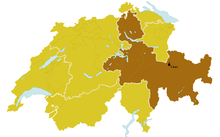Roman Catholic Diocese of Chur
|
Diocese of Chur Dioecesis Curiensis Bistum Chur |
|
|---|---|

|
|
| Location | |
| Country | Switzerland |
| Territory | Graubünden, Schwyz, Uri, Glarus, Obwalden, Nidwalden, Zurich |
| Metropolitan | Immediately Subject to the Holy See |
| Statistics | |
| Area | 12,272 km2 (4,738 sq mi) |
| Population - Total - Catholics |
(as of 2013) 1,859,376 650,660 (35%) |
| Information | |
| Denomination | Roman Catholic |
| Sui iuris church | Latin Church |
| Rite | Roman Rite |
| Cathedral | Cathedral of the Assumption |
| Patron saint | St Lucius of Chur |
| Secular priests | 590 |
| Current leadership | |
| Pope | Francis |
| Bishop | Vitus Huonder |
| Auxiliary Bishops | Marian Eleganti |
| Vicar General | Martin Grichting |
| Emeritus Bishops |
Amédée Grab Bishop Emeritus (1998-2007) Peter Henrici Auxiliary Bishop Emeritus (1993-2007) Paul Vollmar Auxiliary Bishop Emeritus (1993-2009) |
| Map | |
 |
|
| Website | |
| Website of the Diocese | |
The Diocese of Chur extends over the Swiss Cantons of Graubünden (Grisons), Schwyz, Glarus, Zurich, Nidwalden, Obwalden and Uri.
A Bishop of Chur is first mentioned in 451/ 452 when its Bishop Saint Asimo attended the Synod of Milan, but probably existed a century earlier. The see was at first suffragan to the archbishop of Milan, but after the treaty of Verdun (843) it became suffragan to Mainz. In consequence of political changes it became, in 1803, immediately subject to the Holy See. According to local traditions, the first Bishop of Chur was Saint Lucius, who is said to have died a martyr at Chur around the year 176, and whose relics are preserved in the cathedral. St. Lucius is venerated as the principal patron of the diocese. (See G. Mayer, "St. Luzi bei Chur", Lindau, 1876.) The country had to pass through very severe struggles for the Christian faith. Theodoric, King of the Ostrogoths, and the Lombards after him, attempted to introduce Arianism in the sixth and seventh centuries.
The bishop soon acquired great temporal powers, especially after his dominions were made, in 831, dependent on the Empire alone. In the dispute between Emperor Barbarossa and Pope Alexander III, Bishop Egino of Chur sided with the emperor and was rewarded with the dignity of Prince of the Empire in 1170. The bishop was also temporal lord of the city, and in several cases a better warrior than pastor. In 1392 he became head of the League of Gods House (originally formed against him in 1367), one of the Three Leagues, but, in 1526, after the Reformation, lost his temporal powers, having fulfilled his historical mission (see Graubünden).
...
Wikipedia
